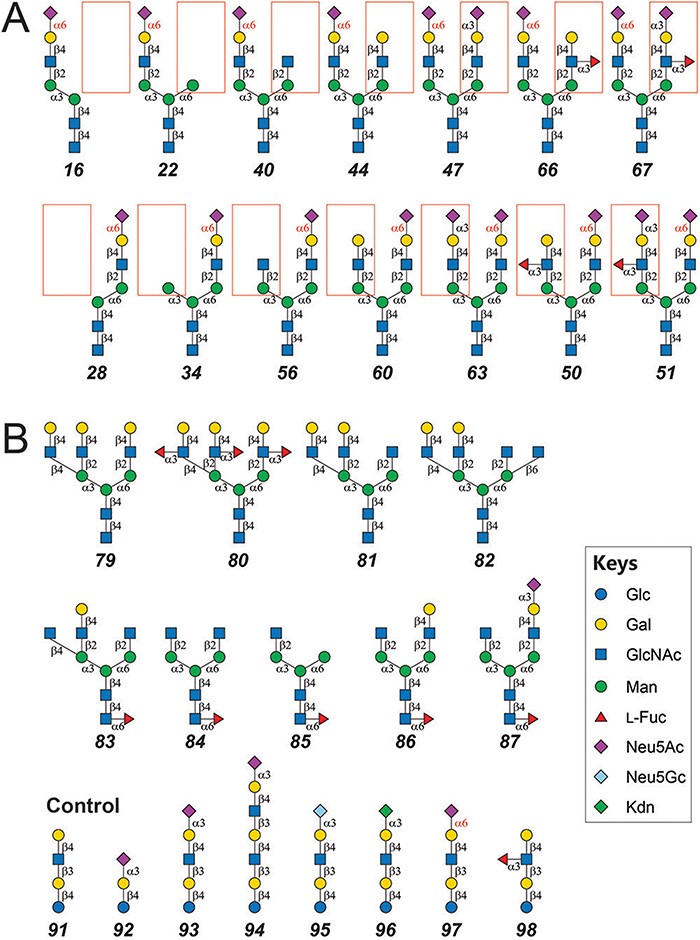Glycan Branching Analysis Service
Glycan chains are oligosaccharide or polysaccharide structures formed by monosaccharides connected through specific glycosidic bonds, widely present in glycoproteins, glycolipids, and on cell surfaces. They are important mediators of cell communication, signal transduction, and molecular recognition. Glycan branching refers to the structural feature where multiple side chains form at specific monosaccharide residues. This branching directly affects the spatial conformation, stability, and binding capacity of the glycan molecule with receptors or ligands. This analysis typically relies on high-resolution mass spectrometry (MS), high-performance liquid chromatography (HPLC), and other techniques to precisely determine the branching type and degree by analyzing mass, linkage patterns, and monosaccharide composition.
The glycan branching analysis service has wide applications in multiple fields, including revealing disease-related glycosylation abnormalities (such as in cancer, autoimmune diseases, and neurodegenerative diseases), assessing the consistency and stability of biopharmaceuticals (such as glycoprotein drugs), studying cellular signal transduction and immune regulation mechanisms, and providing structural insights for vaccine development, glycoengineering, and functional food development.

Li, L. et al. Glycobiology, 2020.
Figure 1. Examples of N-Glycans that Share One Identical Branch but Differ in the Other.
Services at MtoZ Biolabs
Based on high-resolution mass spectrometry combined with high-performance liquid chromatography platforms, MtoZ Biolabs offers the glycan branching analysis service which provides precise analysis of glycan branching structures in glycoproteins, glycolipids, and various biological samples. This service can analyze the branching type, branching sites, number of branches, and relative abundance of glycans, along with monosaccharide composition and linkage information, to examine the glycosylation structural characteristics. It helps reveal changes in glycosylation patterns and their functional significance.
Analysis Workflow
1. Sample Preparation
Samples are pre-treated to remove impurities, ensuring the integrity of glycan branching components for subsequent analysis.
2. Glycan Extraction and Enrichment
Enzymatic or chemical methods are used to extract glycan chains from samples, and specific enrichment techniques are employed to isolate the target glycans, ensuring analysis accuracy.
3. Derivatization
Glycan chains are derivatized as needed to enhance their detectability and analysis sensitivity, ensuring accurate separation and quantification.
4. Separation and Analysis
High-resolution mass spectrometry platforms are used to separate, identify, and quantify the extracted glycan chains, precisely analyzing the branching types and quantities of the glycans.
5. Data Processing and Report Generation
Bioinformatics analysis is performed to interpret the results, and a detailed report is generated, providing information on the glycan branching composition, structure, and distribution, offering valuable data support for further research.
Service Advantages
1. Comprehensive Structural Analysis
This service provides a thorough analysis of glycan branching patterns, monosaccharide composition, and spatial conformation, offering detailed structural information to support glycosylation research.
2. High Sensitivity
With derivatization and optimized analysis methods, the service can detect low-abundance glycan branches, making it suitable for analysis of complex biological samples.
3. Customized Analysis Plan
Personalized analysis plans are provided based on the client’s research objectives and sample characteristics, ensuring solutions tailored to meet various research needs and challenges.
4. One-Stop Service
We offer a complete one-stop service, from sample preparation, glycan extraction, and analysis to result interpretation, simplifying the experimental process and improving data acquisition efficiency.
Applications
1. Biopharmaceutical Quality Control
In the production of glycoproteins, glycolipids, and other biopharmaceuticals, analyzing the composition and stability of glycan branching ensures the consistency and stability of product quality.
2. Cancer Research
The glycan branching analysis service can be used to study the relationship between changes in glycan branching patterns and tumor occurrence and progression, providing data support for early cancer diagnosis and therapeutic target identification.
3. Glycomics Research
By analyzing glycan branching patterns, this service reveals the crucial roles of glycosylation in biological processes such as cell recognition, signal transduction, and immune regulation, advancing the field of glycomics research.
4. Food and Nutrition Research
The glycan branching analysis service can be used to analyze glycan branching in food, studying its impact on nutrient absorption and metabolism, ensuring food formulation standardization, and driving the development of functional foods and nutritional products.
FAQ
Q1: Will Glycan Branching Analysis Affect the Structure of the Glycan Chain?
A1: No. The derivatization techniques and analytical methods we use enhance the sensitivity and stability of the glycan chain detection but do not alter the basic structure of the glycan chain. This ensures that the glycan chain remains consistent before and after analysis, accurately reflecting its original state.
Q2: Can Multiple Types of Glycan Branching Be Analyzed?
A2: Yes, we can analyze various types of glycan branching, including N-linked and O-linked glycans, as well as their different branching structures. Additionally, we can detect different monosaccharide residues in the glycan chain and their linkage patterns, providing a comprehensive understanding of the complexity of glycan branching.
Deliverables
1. Comprehensive Experimental Details
2. Materials, Instruments, and Methods
3. Data Analysis, Preprocessing, and Estimation
4. Bioinformatics Analysis
5. Raw Data Files
Related Services
Glycan Linkage Analysis Service
Glycan Composition Analysis Service
How to order?







